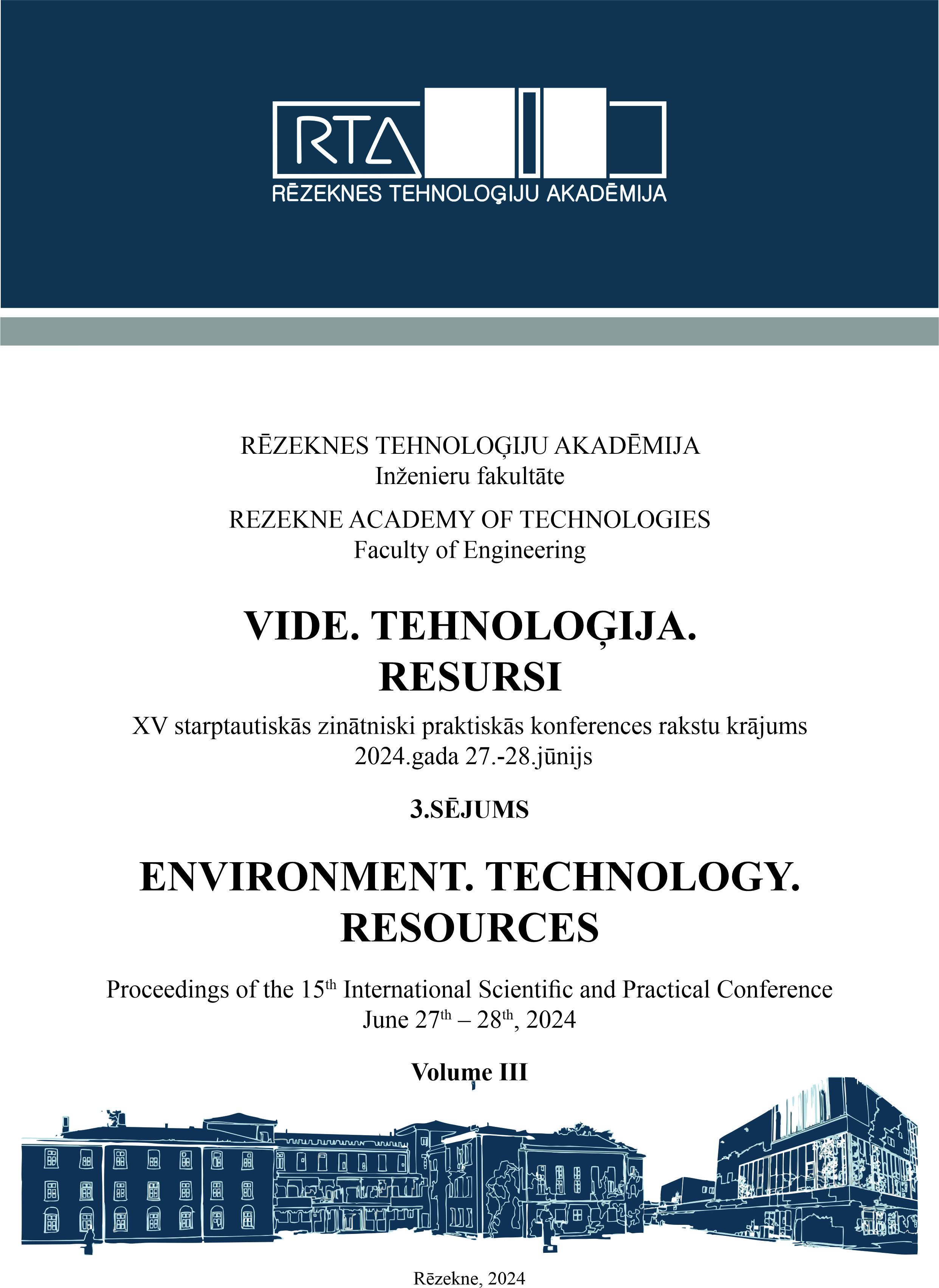STUDY OF ADHESION OF PHYSICAL VAPOR DEPOSITION COATINGS ON FUNCTIONAL TEXTILE WITH LASER POST-PROCESSING
DOI:
https://doi.org/10.17770/etr2024vol3.8178Keywords:
functional textile, laser post-processing technologies, magnetron vacuum sputtering, peel-off tape adhesion testAbstract
Functional textile are one of the most critical fields in the textile industry and textile materials science. In recent years, advanced technologies in textile processing have become relevant in order to improve its usability. In the production of various types of functional textile, one of the methods is the modification of textile surfaces. To improve the properties of the textile surface, magnetron vacuum sputtering and laser post-processing technologies can be used, which in general gives the material new or improved properties and functionalities. In this study, mixed fiber fabrics containing polyester, protal and cotton fibers are used to determine how laser post-treatment of the metalized fabrics impact the adhesive properties between fabric and deposited metal. The following materials were used for magnetron vacuum sputtering for functional textile coatings: Cu, Al, Ti, Ag. Individually or by combining these metals, it is possible to assign the textile such properties as: electromagnetic, UV and IR radiation shielding; antistatic, antibacterial, hydrophilic and hydrophobic properties, as well as increasing wear resistance. In this study a 100 W continuous wave CO2 laser with a wavelength of 10.6 µm is used for post-treatment of magnetron vacuum sputtered modified textile surfaces. The study's conclusions point towards a tailored approach in determining linear energy densities that bolster adhesion for each metal-textile combination, which is essential for the development of durable and functional advanced textile. The patterns noted in the adhesion strengths, influenced by different energy densities and metal types, highlight the intricate relationship between the thermal impact of laser treatment and the inherent characteristics of the metals deposited. Some metals demonstrated improved adhesion at lower energy densities. However, a general trend emerged showing a reduction in the strength of adhesion as the energy density increased, especially when surpassing certain energy levels.References
P. Kiekens, E. Van der Burght, E. Kny, T. Uyar, R. Milašius, Functional textiles – from research and development to innovations and industrial uptake. AUTEX Research Journal, Vol. 14, No 4, December 2014. DOI: 10.2478/aut-2014-0031 © AUTEX
A. Ojstršek, O. Plohl, S. Gorgieva, M. Kurečič, U. Jančič, S. Hribernik, D. Fakin, Metallisation of Textiles and Protection of Conductive Layers: An Overview of Application Techniques. Sensors 2021, 21, 3508. https://doi.org/ 10.3390/s21103508
D. Gupta, Functional clothing—Definition and classification. Indian Journal of Fiber and Textile Research. 2011; 36(4):321-326
N. Pan, G. Sun, Functional Textiles for Improved Performance, Protection and Health. Sawston, United Kingdom: Elsevier; Copyright © 2011 Woodhead Publishing Limited.
Xue-Qiang Tan, Jian-Yong Liu, Jia-Rong Niu, Jia-Yin Liu, Jun-Ying Tian. Recent Progress in Magnetron Sputtering Technology used on fabrics. 2018. DOI:10.3390/ma11101953
Mei-Lin Huang, Ying-Zhu Wu, Zhi-Kai Liu, Sheng-Guo Lu. Metallic coloration and multifunctional preparation on fabrics via nitriding reactive sputtering with copper and titanium targets, Vacuum, Volume 202, August 2022. https://doi.org/10.1016/j.vacuum.2022.111177
L. Surdu, E. Visileanu, A. Ardeleanu, C. Mitran, I. Răzvan Rădulescu, C. Stancu, I. Sandulache, B. Mitu, Research regarding the cover factor of magnetron sputtering plasma coated fabrics, January 2019. DOI: 10.35530/IT.070.02.1618
E. Korzeniewska, J. Gocławski, J. Sekulska-Nalewajko, M. Walczak, B. Wilbik-Hałgas, Changes in Fabric Surface Pilling under Laser Ablation. MDPI, October 2020. https://doi.org/10.3390/s20205832
Y. P. Angelova, Factors influencing the laser treatment of textile materials: An overview. Journal of Engineered Fibers and Fabrics, September 2020. https://doi.org/10.1177/1558925020952803
T. Atwee, N. Elshafei, H. Y. Mostafa, F. Bassynouni, Surface Treatments using CO2 Lasers on a Variety of Synthetic Textiles. J Mater sci Appl 6: 1-9, March 2022. DOI:10.17303/jmsa.2022.6.103
J. Bonse, S. Gräf, Ten Open Questions about Laser-Induced Periodic Surface Structures. Nanomaterials 2021, 11(12), 3326; https://doi.org/10.3390/nano11123326
M. Sabri Salim, T. K. Naseer Sabri, M. Ibrahim Noaman, N. Noaman Israa, H. Akram Israa Latif, Effect of laser processing parameters on the efficiency of material: a review in industrial application field., International Journal of Engineering & Technology, 2019. DOI: 10.14419/ijet.v8i4.29729
POLYCOTTON FABRIC [Online]. Available: https://www.klopman.com/polyester-cotton#fabric/23712 [Accessed: Febr. 02, 2024].
M. Vančo, J. Krmela, F. Pešlová., The Use of PVD Coating on Natural Textile FibersProcedia Engineering, Volume 136, 2016, Pages 341-345. https://doi.org/10.1016/j.proeng.2016.01.220
What is Protal? [Online]. Available: https://www.protal.co.uk
[Accessed: Febr. 02, 2024].
Sheng Qiu, Hao Jia, Shou-xiang Jiang, Fabrication and characterization of thermal management fabric with heating and cooling modes through magnetron sputtering. Materials Letters, Volume 300, 1 October 2021, 130217. https://doi.org/10.1016/j.matlet.2021.130217
Xiao Zhang, Shouxiang Jiang, Ming Cai, Hongmei Zhao, Fukui Pan, Dagang Miao, Xin Ning. Magnetron sputtering deposition of Ag/Ag2O bilayer films for highly efficient color generation on fabrics. Ceramics International, Volume 46, Issue 9, 15 June 2020, Pages 13342-13349. https://doi.org/10.1016/j.ceramint.2020.02.113
B. Subramanian, K. Anu Priya, S. Thanka Rajan, P. Dhandapani, M. Jayachandran, Antimicrobial activity of sputtered nanocrystalline CuO impregnated fabrics. Materials Letters, Volume 128, 1 August 2014, Pages 1-4. https://doi.org/10.1016/j.matlet.2014.04.056
S. Shahidi, M. Ghoranneviss, B. Moazzenchi, A. Anvari, A. Rashidi, Aluminum coatings on cotton fabrics with low temperature plasma of argon and oxygen. Surface and Coatings Technology, Volume 201, Issues 9–11, 26 February 2007, Pages 5646-5650. https://doi.org/10.1016/j.surfcoat.2006.07.105.
E. Linden, P. Vitruk, SuperPulse 10.6um CO2 laser-assisted, closed flap treatment of peri-implantitis. Implant Practice-US. 8. 30-34, 2015.
S. Katayama, Handbook of Laser Welding Technologies; Woodhead Publishing: Cambridge, UK, 2013.
A. E. Karnoukhov, Y. A. Timoshina, E. F. Voznesensky, V. A. Sysoev, I. V. Krasina, & N. V. Tikhonova, Study of the adhesion of metal coatings on synthetic textile materials. Journal of Physics: Conference Series, 1954(1). 2021. https://doi.org/10.1088/1742-6596/1954/1/012016
Downloads
Published
Issue
Section
License
Copyright (c) 2024 Silvija Mežinska, Antons Pacejs, Imants Adijāns, Edgars Zaicevs, Lyubomir Lazov

This work is licensed under a Creative Commons Attribution 4.0 International License.



